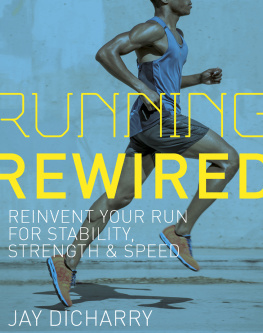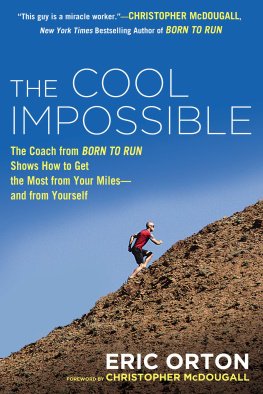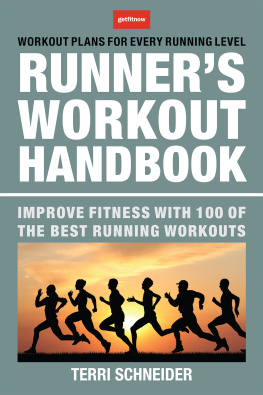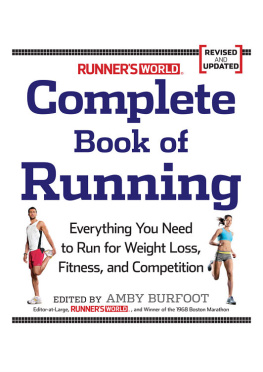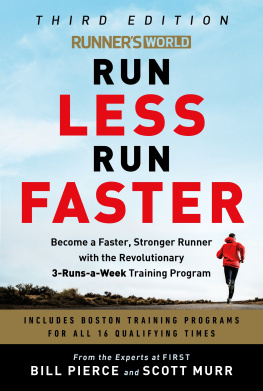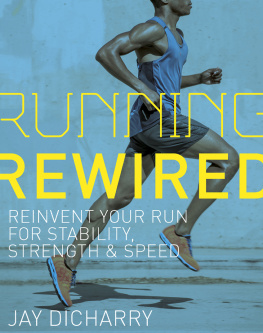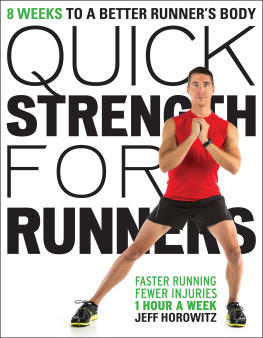

Copyright 2017 by Jay Dicharry
All rights reserved. Published in the United States of America by VeloPress.
CrossFit is a registered trademark of CrossFit, Inc.
Ironman is a registered trademark of World Triathlon Corporation

3002 Sterling Circle, Suite 100
Boulder, CO 803012338 USA
VeloPress is the leading publisher of books on endurance sports. Focused on cycling, triathlon, running, swimming, and nutrition/diet, VeloPress books help athletes achieve their goals of going faster and farther. Preview books and contact us at velopress.com.
Distributed in the United States and Canada by Ingram Publisher Services
The Library of Congress has cataloged the printed edition as follows:
Name: Dicharry, Jay, author.
Title: Running rewired: reinvent your run for stability, strength & speed / Jay Dicharry.
Description: Boulder, CO: VeloPress, 2017. | Includes index. |
Identifiers: LCCN 2017049243 (print) | LCCN 2017049506 (ebook) | ISBN 9781948006019 (ebook) | ISBN 9781937715755 (pbk.: alk. paper)
Subjects: LCSH: RunningTraining. | RunningPhysiological aspects.
Classification: LCC GV1061.5 (ebook) | LCC GV1061.5 .D53 2017 (print) | DDC 796.42dc23
LC record available at https://lccn.loc.gov/2017049243
Cover design by Kevin Roberson
Cover photograph by Tim De Frisco
Interior photographs by Jeff Clark
Illustrations by Charlie Layton
Location courtesy of Kevin Boss, Boss Sports Performance
v. 3.1
To my kids, my future is happier with you
To my wife, who always looks for the positive
To my parents, for providing support and opportunity
To my mentors, who pushed me
To my friends, who let me be myself
To chocolate, for being delicious
To the musicians of my hometown, NOLA, your music moves us
CONTENTS
Setting Yourself Up for Success
Theres that feeling that you get after you crush a workout, hit a new PR on race day, or beat your friend to the top of the local hill or high alpine peak. Its a feeling of success... and it feels good, really good. We thrive on challenge, and train in pursuit of this feeling of success. Every runner knows that it takes a lot of hard work to get there. But a lot of runners get confused by this concept: They end up interpreting a lot of hard work to mean a high volume of work. In the quest to log the miles its easy to lose sight of the quality of those miles. First place isnt awarded to the person who racks up the highest weekly mileage or trains the hardest. Instead, medals adorn the necks of those who nail the fundamentals, which in turn allows them to train consistently and successfully. Youve got to put in the miles to get fit, but how can you be sure that your training is setting you up for success? Put simply, there are things that all runners of all abilities should be doing outside running to improve their running. If you want to run better, you need to move better.
Discussions about running better invariably seem to lead to the topic of form, but before we go there lets take a step back and look at reality. How you run is an expression of you and your experience. You probably arent a Tarahumara Indian and you probably arent a Kenyan. We all envy the perfect posture, leg drive, and effortlessly springy gait of these runners. That idealized stride wasnt a result of being born at elevation or bestowed with great geneticsit was built through skilled movement. It was lifestyle that wired these runners bodies for postural alignment and efficient muscle recruitment, first as children playing in the field, later working in those fields, and eventually through a lot of hard training that led them to beat the entire field. If we consider how a lifestyle structured around physical activity and progressive running factors in, its not the case that the Kenyan and Tarahumara cultures are born to run; rather, their bodies have adapted to run. Conversely, it should come as no surprise that our own lifestyle, built around modern conveniences and topped off with a bunch of running, doesnt produce the same results.
Training to move better
Movement skill is critical. Athletes competing in ball sports spend the bulk of their time training their bodies to move better. Through practice they build a strategy that can be put to use every time they step onto the turf, field, or court. They know how to execute good form before the first ball is put into play. Fighter pilots refine their reflexes until they reach a point where they can fly intuitively. Your 105-pound neighbor can nail yoga poses youve only seen in pictures, not because shes strong, but because shes skilled. You dont step into the huddle, into a cockpit, or into a one-handed handstand on the yoga mat until you have a baseline of skill preparation. Likewise, highly efficient runners have mastered the skill of running.
The legendary running coach Joe Vigil once said, Its hard being a running coach because the kids who show up for practice are highly motivated, but they are the same kids that lacked the athleticism to make the team in [insert sport-of-choice]. These kids are steeped in the promise that work ethic can beat talent given enough time and determinationthey get out of bed, lace up their shoes, and run. Sometimes they run easy, sometimes hard, and sometimes even harder. Many of them end up running themselves into the ground, missing peak potential, or worse yet, missing training due to injury. But harder doesnt mean better and volume doesnt make champions.
There are specific skills that you should have in your running toolbox. The repetitive nature of running means that many of us take a body that really doesnt know how to move at its best and rack up the mileage. Through years of repetition you wire your body to move one way and run one way. Then when someone comes along and tells you that you need to improve your form, or move a different way, you cant simply do what they are saying. You havent built the muscle memory to move differently. Even subtle changes to your running form feel awkward and hard. You cant help but notice that your form still looks nothing like that of the Kenyans. And your times arent improving. A lot of runners have conducted this experiment and failed, concluding that focusing on form is a waste of time. Well, there is a better way to run better.
It starts with this little secret: Your body drives your running form. The old adage says form follows function. Likewise, running form follows body function. Running better requires you to move better. Under stress. Under fatigue. And under the hot sun with your archrival breathing down your neck. In these moments, you dont have the luxury of going over an eight-point mental checklist on running form and body awareness. You should have learned that routine a long time ago. If not, that time begins now.
Think about where you are right now as a runner, and where youd like to be. Everyone wants running to feel smooth, efficient, and less stressful. To hit that goal requires you to train in a way that is more well rounded and more athleticbut always with the intention of specifically improving your running. We are all busy, and adding more to what you are already doing can seem like a big ask. But this process will be fun, because youll feel yourself improving in ways youve never experienced. Well explore specific strategies to improve your movement and re-invent your run.
Next page
